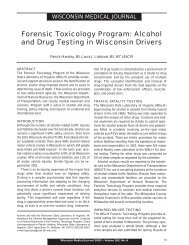WMJ 108no9 - Wisconsin Medical Society
WMJ 108no9 - Wisconsin Medical Society
WMJ 108no9 - Wisconsin Medical Society
Create successful ePaper yourself
Turn your PDF publications into a flip-book with our unique Google optimized e-Paper software.
hands, legs, and feet. These spasms,<br />
which are precipitated by a variety of<br />
stimuli—including physical exercise,<br />
light, abrupt noises, physical contact<br />
(including attempts to elicit muscle<br />
stretch reflexes on physical exam) and<br />
extreme emotions—have substantially<br />
decreased the patient’s quality of life,<br />
requiring him to spend most of his time<br />
indoors so as to avoid any provocative<br />
stimuli.<br />
SPS is rare disorder—only approximately<br />
150 cases have been reported in<br />
the medical literature through the past<br />
25 years. Three main subtypes of this<br />
syndrome are thought to exist, including<br />
autoimmune paraneoplastic and<br />
idiopathic variants. This patient’s past<br />
medical history of pernicious anemia<br />
suggested the possibility of an autoimmune<br />
variant and a trial of plasmapheresis<br />
was undertaken.<br />
lyme Meningitis<br />
Ismael Tura, MD, Julia Usatinsky,<br />
MD; Aurora Sinai <strong>Medical</strong> Center,<br />
Milwaukee, Wis<br />
Case: A 35-year-old man presented to<br />
the outpatient clinic with right-sided<br />
facial weakness of 1-day duration. He<br />
also complained of severe headaches,<br />
generalized fatigue, diffuse arthralgias,<br />
and myalgias for approximately 3 weeks<br />
prior to the onset of facial weakness.<br />
On further questioning, he remembered<br />
erythematous rash following an<br />
insect bite 6 weeks prior to this presentation.<br />
This was treated as cellulitis<br />
elsewhere, with resolution of rash. The<br />
patient was started on amoxicillin, and<br />
Lyme titer returned positive. To resolve<br />
the patient’s headache, lumbar puncture<br />
was done and results were positive<br />
for Lyme meningitis. The patient was<br />
treated with a 28-day course of ceftriaxone<br />
with complete resolution of all<br />
symptoms.<br />
Discussion: We present this case to<br />
increase the index of suspicion among<br />
clinicians in <strong>Wisconsin</strong>, where incidence<br />
of Lyme disease is among the highest in<br />
the nation, and illustrate that outcomes<br />
of this disease are dependent on early<br />
recognition. The most common clinical<br />
manifestation of early Lyme disease<br />
is erythema migrans, which typically<br />
develops within 7-14 days after tick<br />
detachment and present as a rapidly<br />
470<br />
expanding, usually single, erythematous<br />
lesion with central clearing. It resolves<br />
spontaneously, but if left untreated,<br />
patients develop serious clinical sequelae.<br />
Appropriately treated patients have<br />
cure rates exceeding 90%. Serologic<br />
testing is not helpful at this point as<br />
seroconversion occurs later. Patient<br />
with skin rash suggestive of erythema<br />
migrans and suspicious clinical and epidemiological<br />
history should be treated<br />
without any further testing.<br />
Hematologic Manifestations<br />
of pancreatic Cancer<br />
Adarsh Varma, MD, Bret J. Spier,<br />
MD, Patrick R. Pfau, MD; University<br />
of <strong>Wisconsin</strong> Hospitals and Clinics,<br />
Madison, Wis<br />
Case: A 60-year-old man, who was otherwise<br />
healthy, presented with 1 month<br />
of fatigue, and a 20-pound unintentional<br />
weight loss. His friends noticed<br />
a yellowing of his skin, and he experienced<br />
prolonged bleeding after shaving.<br />
Prior to presentation, the patient was<br />
on no medications, had no allergies, and<br />
social and family history were noncontributory.<br />
On physical examination, the<br />
patient was afebrile and hemodynamically<br />
stable. The patient was jaundiced<br />
with associated scleral icterus. On the<br />
patient’s face there were scattered cuts<br />
from the morning’s shave, and otherwise<br />
his abdomen was soft, nontender,<br />
nondistended, with no associated hepatosplenomegaly.<br />
Labs on admission<br />
revealed hemoglobin 11.9 (13.5-18.0 g/<br />
dL), platelets




